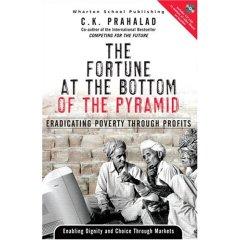Thursday, July 21, 2005
Destined to be the CSR Book of the Year
 Profitable poverty alleviation creates a ‘newfrontier’ for corporate responsibility
Profitable poverty alleviation creates a ‘newfrontier’ for corporate responsibilityThe Financial Times carried a story about howGrupoNueva aims to target the world’s poor as apotential market by aiming to design and sellaffordable wood and water pipeline products to thisvast segment of the world’s population. The company,it said, was aiming to show how profitability and corporate responsibility can go hand in hand.The move is one of the first responses to thereasoning behind the recent book by C.K.Prahalad, ‘TheFortune at the Bottom of the Pyramid’.
Prahalad’s premise is that the intelligent application of marketscan create a real breakthrough in tackling global poverty. After all, he points out, for more than 50years the World Bank, donor nations, aid agencies,governments and others have taken what steps theycould – but have failed to eradicate poverty. It remains the world’s most visible and daunting problem. There has to be a better approach to alleviatepoverty. The innate potential of the poor to innovateand create enterprise needs to be unleashed. Companies should actively provide products and services whichmeet real needs affordably and profitably.This is not about community investment programmes.
With the best will in the world, global poverty willnot be solved by corporate philanthropy. It is about offering choices to the poor, building self-esteem andcreating a positive upward-spiral effect.There are some basic assumptions behind this approach.The first of these is that companies do most damage tothe poor if they ignore them and their needsaltogether. The benefits of globalisation won’t berealised so long as the poor have no access to them.The second is that there needs to be real innovationto serve such markets – products developed for wealthymarkets cannot simply be transferred to serve the‘bottom of the pyramid’ markets. Thirdly – this iscore business. A choice to focus in this area may bepart of a company’s approach to corporateresponsibility, but to be sustainable it needs to berun as any other part of a profitable business. It isnot about charity.Why have companies not rushed to embrace such conceptsin the past? Predominantly, because of certain beliefs about the nature of these markets that are highly opento challenge.One such belief is that there is no money amongst thepoorest communities. And yet the aggregate purchasing power in poor economies can be immense.
Economies of scale enter a new dimension when there are literallybillions of people involved. Using a figure based ondollar purchasing power parity, China is a $5 trillioneconomy, for instance.Another belief is that such markets are not brandconscious. In fact, the markets are very brandconscious, but they are also extremely valueconscious. Aspirational brands are as important forthese consumers as for many others.The logic of developing products for poor consumersis, however, a different one to the traditional. Thebasic economics is based on small unit packages, lowmargin per unit with high volume. Products need to bedesigned to work in areas where infrastructures may bepoor, and distribution mechanisms need to berethought.All well and good. But can it really work? At a recentBusiness in the Community event at the British Museum,Niall Fitzgerald gave several examples from the workof Unilever, which has been one of the most activecompanies in this area (the examples are also given inthe book). For instance, in India more than 70 millionchildren suffer from iodine deficiency. HindustanLever (HLL), a Unilever subsidiary, produced aninnovative process for treating salt which meant thatit would retain its added iodine content in spite ofthe harsh environmental conditions. It created aniodised salt which only released the chemical once thesalt had been eaten and not before. The venture hasproven to be both beneficial to health, and profitablefor the company.Another example is that of how Hindustan Lever addressed the soap market. Diarrhoea is a major causeof death, creating 2.2 million deaths annually. A significant difference to such figures can be madewith some basic improvements in hygiene practices,even to such a simple level as washing hands withsoap. Amongst children in developing countries,washing hands can reduce diarrhoea fatalities by 50percent. So HLL realised that health-based educationwas going to be key to the development of theirmarket.The company approached village schools to educatechildren on the causes of disease, using ultravioletdirt to show the difference between ‘clean-lookinghands’ washed in dirty water, and those washed withsoap. The children often became the most educated inthe family on hygiene, and so began educating theirparents. For a country where the population issignificantly not reached by electronic media, such aprocess was a powerful way to get messages out.There are many other aspects to how such markets canbe made to work. There has to be a revolutionaryapproach to the use of technology. Eco-efficiencyneeds to be highly advanced.
Distribution systems are completely different (HLL operates through 250,000individual entrepreneurs in villages).Julio Moura, GrupoNueva president told students at theLondon Business School that his company’s aim to reachto such markets represented ‘a new frontier’ forcorporate responsibility. It could well be that hisconviction in this area will be the first of many.Prahalad’s book could well turn out to be one of themost influential books of its time, and it is certainly required reading for anyone serious aboutthe role of business in society.
Subscribe to Comments [Atom]
